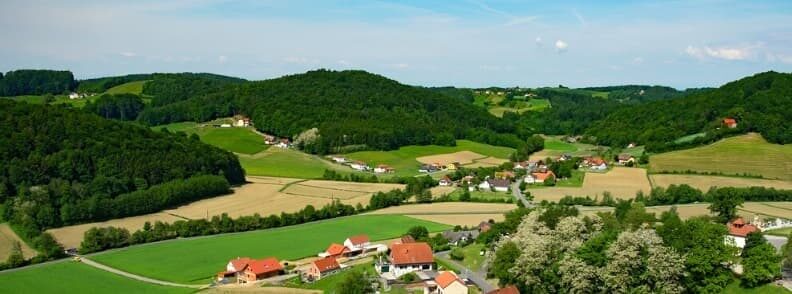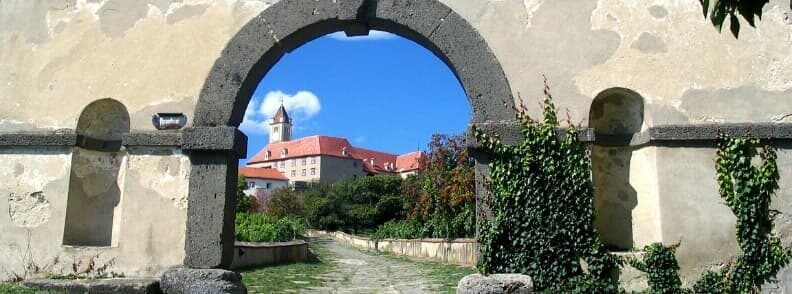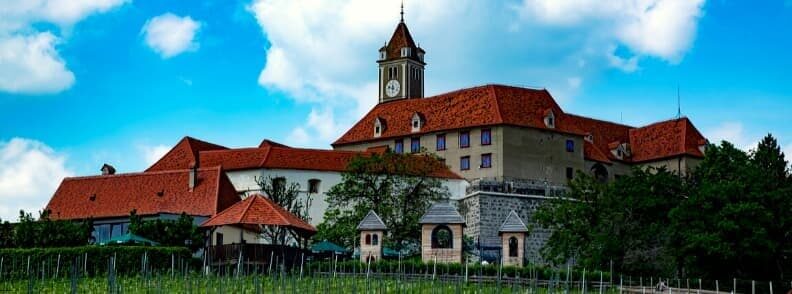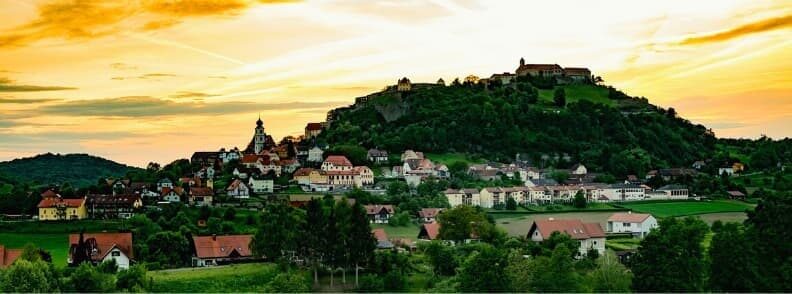Growing up in Styria, Austria, I was always surrounded by the region’s rolling hills, vineyards, and an undeniable sense of history. Castles dotted the landscape, standing as silent witnesses to the past, but none captured my imagination quite like Riegersburg Castle. It wasn’t just a place we visited on school trips or family outings; for me, Riegersburg Castle was a portal to another world, one filled with legends of knights, witches, and ancient battles. Each visit left me in awe of its towering presence, perched high on a volcanic rock, commanding attention from miles around.
As a child, I remember being fascinated by the castle’s fortifications. My friends and I would run around, pretending to defend the castle from invaders, just as it had once done against Ottoman forces. But Riegersburg Castle was more than just a playground for our imaginations. It was a symbol of the resilience and strength that defines Styria. Walking through its ancient halls, you couldn’t help but feel connected to the generations that had come before, who had lived, fought, and thrived in this very region.
For locals, Riegersburg Castle is more than just another tourist attraction. It’s woven into the fabric of Styrian culture and history. From its impressive architecture to the stories of Katharina Paldauf and the region’s rich past, this castle represents the heart and soul of Styria. Growing up, we were always reminded of the importance of these castles in Styria. These castles weren’t just relics of the past but living pieces of our heritage, places where history and legend intertwine.
If you’re planning to visit Riegersburg Castle, you’re not just ticking off another spot on your Austrian travel itinerary. You’re stepping into a living piece of Styrian history, one that has stood the test of time, weathered wars, and now invites visitors to explore its mysteries. Whether you’re a history buff, a lover of architecture, or someone simply seeking the best panoramic views in the region, Riegersburg Castle offers a captivating experience that stays with you long after you leave its gates.

Where Is Riegersburg Castle?
Riegersburg Castle is nestled in the heart of Styria, a picturesque region in southeastern Austria known for its lush landscapes, vineyards, and centuries-old castles. But before you can experience the majesty of Riegersburg Castle, it’s important to know exactly where Styria is located in Austria and how best to get there.
Styria, also called Steiermark, is the second-largest state in Austria and is easily accessible from major cities like Graz and Vienna. Graz, the capital of Styria, is only about 45 minutes away by car, making it an ideal day trip for visitors staying in the city. As you drive through Styria Austria, you’ll pass charming towns and villages that give you a taste of the region’s rural beauty. If you’re starting your journey from Graz, all you need to do is follow the A2 highway toward Vienna, then take the exit toward Riegersburg. For those coming from smaller towns like Feldbach, the drive to Riegersburg Castle is a short 10-minute trip through the scenic Styrian countryside.
Wondering exactly where is Styria in Austria? It lies in the southeast, bordering Slovenia to the south and surrounded by the towering Alps to the north. Known for its rich cultural history and lush green landscapes, Styria is often referred to as Austria’s green heart. With its iconic Styria flag proudly flown across the region, the province offers some of the most stunning views in Austria. For those who love road trips, driving through this region is a real treat. If you enjoy scenic drives like the one from Murau to Riegersburg, you’ll be captivated by the rolling hills, picturesque vineyards, and the occasional glimpse of a castle perched high above.
If you’re relying on GPS to find Riegersburg Castle, simply plug in Riegersburg Steiermark or check a Styria map to find the best route. With several parking options near the base of the castle, you’ll have no trouble getting there. Once you arrive, prepare to be amazed by the sight of the castle standing dramatically atop a volcanic rock, offering breathtaking views of the surrounding region. Whether you’re coming from Graz, Vienna, or a nearby town, Riegersburg Castle is easy to find and well worth the trip for its rich history and unforgettable vistas.
A Brief History of Riegersburg Castle
Riegersburg Castle is not only a testament to Steiermark Austria’s architectural prowess, but it also carries a fascinating history that intertwines with the legends and lives of those who shaped the region. One such figure is Katharina Paldauf, whose name is forever tied to the castle’s past. Paldauf, often referred to as the Witch of Riegersburg, was one of the many women accused during the infamous witch trials of the 17th century. Legend has it that she used her beauty and influence to manipulate powerful figures, leading to her tragic downfall. Her story continues to haunt the castle, adding an eerie layer to its historical richness.
But beyond these local legends, Riegersburg Schloss played a crucial role in defending the region during the Ottoman invasions. Positioned strategically atop a volcanic rock, the castle was nearly impregnable, and its strong fortifications helped it withstand numerous attacks. The fortress became a symbol of Styria’s resilience and determination, standing tall against external threats while protecting the villages that lay in its shadow.
The castle’s history is also steeped in the tales of its powerful owners, including the feuding barons and counts of the region. Each left their mark on the castle, reinforcing it, expanding it, or embroidering it with their personal stories. Walking through Riegersburg’s halls, you’ll encounter these echoes of the past, from the medieval weaponry displayed in the armory to the ornate rooms that once hosted noble families.
Throughout the centuries, Riegersburg Castle has remained a symbol of strength, resistance, and intrigue. Whether you’re captivated by the drama of Katharina Paldauf’s witch trials or the fierce battles fought on its grounds, the castle’s history is a window into Styria’s fascinating past. This rich tapestry of folklore, historical significance, and cultural heritage makes Riegersburg Schloss a living reminder of the resilience and fortitude of the Styrian people.

Things to Do at Riegersburg Castle
When you arrive at Riegersburg Castle, one of the most beautiful castles in Austria, you’re immediately struck by its dramatic setting. Perched on a volcanic rock, the castle’s imposing fortifications have protected it for centuries, and as you begin to explore, you can’t help but feel like you’re stepping back in time. Wandering through the gates, you’ll pass through towering stone walls, leading you to discover the castle’s rich and storied past.
Start your visit by exploring the castle grounds, where the architecture alone is enough to captivate anyone with an interest in history. The walk up the steep hill is worth every step, as the panoramic views of the surrounding Styrian countryside unfold before you. The castle has multiple layers of defense, from thick walls to secret passages, showcasing the strategic importance of this castle in Austria throughout history. For families, the grounds offer plenty of space to explore, and kids will love imagining life in medieval times, defending the castle from invaders.
Inside, you’ll find several fascinating museums, but none quite as unique as the Witch Museum. This eerie and intriguing exhibit delves into the history of witch hunts in the region, adding a darker layer to the story of Riegersburg Castle. It’s an immersive experience, offering a glimpse into the lives of those accused during one of Europe’s most tumultuous periods.
If you’re visiting during the warmer months, don’t miss the Birds of Prey Show. This is a true highlight for nature lovers. Watching majestic eagles, hawks, and falcons soar above the castle’s high walls is a breathtaking experience. The handlers provide an informative commentary about these magnificent birds, their hunting techniques, and their significance in the region’s natural heritage. It’s not just an educational experience; it’s an unforgettable spectacle set against the stunning backdrop of one of the most iconic castles in Austria.
Whether you’re a history enthusiast or simply looking for a fun day out in nature, Riegersburg Castle has something for everyone. Its blend of history, architecture, and unique attractions make it a must-see for anyone exploring Austria.

Best Views and Photo Spots
One of the most unforgettable aspects of visiting Riegersburg Castle is the breathtaking panoramic views that surround it. Perched atop a towering volcanic rock, the castle offers some of the best photo opportunities in all of Styria. As you stand at the edge of the fortress walls, you can see the rolling hills of South Styria, with its famous vineyards stretching out as far as the eye can see. On a clear day, the horizon seems to go on forever, blending the vibrant green landscape with the pale blue sky — a true feast for the eyes and the camera.
For photographers, both amateur and professional, Riegersburg Castle is a dream location. One of the best spots to capture the essence of Styria is from the western side of the castle grounds. Here, you’ll get a sweeping view of the surrounding countryside, dotted with small villages and winding roads that snake through the hills. As the golden hour approaches, the light softens, casting a magical glow over the landscape, making it the perfect moment to snap a stunning photo of Riegersburg in its full glory.
Another hidden gem for photography lies just beyond the castle walls. If you venture a little further down the hill, you’ll find a viewpoint that allows you to capture the castle itself against the backdrop of the Styrian countryside. This angle gives you a majestic perspective, where the ancient stone walls rise dramatically from the rock, showcasing Riegersburg Österreich in all its grandeur. This spot is especially beautiful in the autumn when the vineyards below turn shades of orange and gold, creating a striking contrast with the castle’s imposing presence.
Whether you’re capturing the lush vineyards of South Styria or the castle’s impressive silhouette, every angle offers a postcard-perfect shot. Don’t forget to take a moment to simply enjoy the view yourself, because while your camera may capture the image, standing there in person gives you a sense of the timeless beauty that makes Riegersburg and Styria so special.
Where to Eat Near Riegersburg Castle
After exploring the historical wonders of Riegersburg Castle, the next question that naturally comes to mind is Where can we eat? Luckily, the area around Riegersburg is known not only for its rich history but also for its exceptional culinary scene. Whether you’re in the mood for traditional Styrian dishes or something more refined, the local restaurants offer a delightful range of options to satisfy your palate.
One place that stands out is Genusshotel Riegersburg, perched on a hill with stunning views of the castle and surrounding vineyards. It’s the perfect spot to relax after a day of sightseeing. Known for its innovative take on Styrian cuisine, the restaurant at Genusshotel serves up a true farm-to-table experience. Here, you can savor dishes crafted from local ingredients, such as the region’s renowned pumpkin seed oil, fresh trout, and beef from nearby farms. My personal favorite is their roasted Styrian chicken, paired with a glass of local white wine, like the crisp and aromatic Sauvignon Blanc.
For something truly special, try the Paldauf Menu, named after one of the local historical figures tied to Riegersburg Castle. This multi-course menu takes you on a culinary journey through Styria, featuring regional delicacies with a modern twist. It’s a great way to immerse yourself not only in the history of the area but also in its vibrant food culture.
Beyond Genusshotel, there are several other fantastic restaurants near Riegersburg. Many local establishments serve hearty Styrian classics like Wiener schnitzel, Käferbohnensalat (bean salad), and Apfelstrudel, perfect for recharging after a day of castle exploration. No matter where you choose to dine, you’ll find that the culinary offerings around Riegersburg are as impressive as the castle itself — authentic, flavorful, and deeply connected to the region’s agricultural heritage.
Practical Information for Visiting Riegersburg Castle
When planning your visit to Riegersburg Castle, it’s essential to know a few practical details to make the most of your trip. The castle is open to visitors from spring through autumn, typically from 9:00 AM to 6:00 PM, though the hours may vary slightly depending on the season. Be sure to check the official website for the most up-to-date information on Schloss Riegersburg Steiermark. Entry tickets are reasonably priced, with discounts available for children, students, and seniors. If you’re traveling as a family, consider purchasing a family ticket to save a bit of money.
To avoid the crowds, aim to visit earlier in the morning or later in the afternoon, especially during the peak summer months. The castle is one of the most popular attractions in Styrian Austria, so it can get quite busy, especially on weekends and holidays. If you prefer a quieter experience, plan your visit on a weekday or during the shoulder seasons in spring and autumn when the weather is still pleasant but the crowds have thinned out.
Accessibility is another important consideration when visiting Riegersburg Castle. Due to its location atop a steep volcanic hill, getting up to the castle can be a challenge for those with mobility issues. While there is a modern funicular that makes the journey easier, it’s worth noting that the castle grounds themselves involve some uneven terrain. Families with young children or elderly travelers should take advantage of the funicular and plan for a slower-paced visit. If you’re traveling with a stroller, be prepared for a bit of extra effort in certain areas.
For those looking to extend their stay in the region, Feldbach Austria offers a charming place to relax, with a selection of cozy accommodations and local restaurants serving traditional Styrian cuisine. Additionally, the Thermenland Styria region, known for its thermal baths and spa resorts, is just a short drive away. After a day of exploring the castle, unwind in one of the region’s renowned thermal spas, soaking in the natural mineral waters that have been attracting visitors for centuries.
If you have more time, consider exploring the nearby city of Graz, a UNESCO World Heritage Site rich in history and culture. Graz offers a perfect contrast to the rural charm of Riegersburg with its vibrant city life, museums, and beautiful architecture. By combining your visit to Schloss Riegersburg with other nearby attractions, you’ll experience the best that Styria has to offer.
Riegersburg Castle Reviews and Visitor Opinions
When it comes to Riegersburg Castle reviews, the overall consensus is overwhelmingly positive, and for good reason. Visitors on platforms like TripAdvisor rave about the stunning location of the castle, perched high atop a volcanic rock, offering panoramic views of the beautiful Styrian countryside. Many reviewers describe the castle as a “must-see” for anyone visiting the region, praising both its historical significance and the unique experiences it offers, from the well-preserved fortress to the engaging exhibitions inside.
One thing that stands out in Riegersburg Castle reviews is the mention of the castle’s fascinating history. Many visitors are drawn in by the tales of the fortress’s role in defending against Ottoman invasions, as well as the legends surrounding figures like Katharina Paldauf, also known as the “witch of Riegersburg”. The castle’s museums, particularly the one dedicated to witch trials, are often highlighted as intriguing, though some visitors note that they wish there were more English explanations throughout the exhibits. If you’re someone who enjoys diving deep into local history, these displays will captivate you, but if you’re traveling with children, you might find that some sections, like the Witch Museum, are more adult-oriented.
From my personal experience, the pros of visiting Riegersburg Schloss are clear. The castle itself is awe-inspiring, both in its size and its strategic location. Walking up to the castle via the steep path feels like a small adventure, but for those less inclined to make the climb, the funicular offers a convenient and scenic ride to the top. Once you’re there, the views are breathtaking, making it an excellent spot for photography enthusiasts. The bird of prey show is another highlight, adding a unique, natural element to the visit, especially for families.
However, some cons come up in reviews, and I agree with them based on my visits. First, the entrance fee can feel a bit steep if you’re visiting with a large family. Additionally, while the funicular is a great option, it can get quite crowded during peak tourist season, leading to longer wait times. Another point to keep in mind is that while the castle grounds are beautiful, some areas aren’t as accessible for those with mobility issues due to the steep terrain.
Overall, Riegersburg Castle offers an unforgettable experience for history lovers, nature enthusiasts, and families alike. While it may have a few logistical challenges, the castle’s charm and historical significance far outweigh any minor inconveniences. Based on the wealth of glowing Riegersburg Castle reviews, and my personal visits, I can confidently say that this is one of the top attractions in Styria that you shouldn’t miss.
Castles in Styria and Surrounding Attractions
Styria is a region rich in history, with castles that seem to rise from every hilltop, offering visitors a glimpse into Austria’s storied past. While Riegersburg Castle is undoubtedly one of the highlights of any trip to the area, it’s just the beginning of what Styria has to offer. For those with a passion for history, architecture, or simply stunning landscapes, exploring the castles in Styria and surrounding attractions makes for the perfect day trip or weekend getaway.
One such destination is the majestic Schloss Herberstein, located about an hour’s drive from Riegersburg Castle. This Renaissance fortress is nestled in the Feistritz valley and not only boasts impressive architecture but also houses a renowned wildlife park. Visitors can spend the morning touring the castle and its stunning gardens, then explore the park, where animals from around the world roam in environments designed to mirror their natural habitats. It’s a great option for families looking to combine culture and nature in one stop.
If you’re feeling adventurous, why not extend your journey beyond Styria’s borders? With Slovenia just a short drive away, you can easily combine your castle explorations with a trip to Maribor, Slovenia’s second-largest city. Known for its medieval architecture and vibrant cultural scene, Maribor is the ideal complement to your tour of Styria’s castles. A scenic drive through rolling vineyards will take you across the Styria-Slovenia border, offering breathtaking views of the countryside along the way.
For those looking for a more off-the-beaten-path adventure, the charming town of Murau should be on your list. Known for its well-preserved medieval town center and picturesque setting along the Mur River, Murau is the perfect spot for a peaceful day trip. Here, you can visit Schloss Murau, a 13th-century castle that has been beautifully restored. After exploring the castle, stroll through the quaint streets, enjoy a meal at a traditional Styrian tavern, and soak in the tranquil atmosphere of this hidden gem.
Whether you’re touring the grand Schloss Riegersburg, venturing into neighboring Slovenia, or discovering the charm of Murau, the castles and attractions in Styria provide endless opportunities for adventure and exploration. Each destination offers its unique blend of history, culture, and natural beauty, ensuring that your trip to Styria will be as enriching as it is memorable.
Why Visit Riegersburg Castle?
When it comes to exploring the treasures of Steiermark, Riegersburg Castle stands out as one of the most breathtaking and historically significant sites in the region. Perched dramatically on a volcanic hill, this fortress isn’t just one of the most beautiful castles in Austria but also a symbol of the resilience and culture that defines Styria. From its imposing stone walls to the legends of witches and battles that echo through its halls, Riegersburg offers visitors a truly immersive experience of Austria’s rich past.
What makes Riegersburg Castle so unique is its combination of stunning architecture and the way it seamlessly blends into the surrounding landscape. Rising above the countryside, it offers panoramic views that stretch as far as the eye can see, capturing the beauty of Styria from every angle. This alone makes it a must-visit for travelers who appreciate natural beauty, history, and striking photo opportunities. Whether you’re climbing the castle walls or simply enjoying the view from below, the sense of awe that comes with visiting Riegersburg is undeniable.
But Riegersburg is more than just a picturesque fortress. It’s a living testament to the history of Styria. The castle’s role as a defensive stronghold against invasions, along with its connection to the notorious witch trials, adds layers of intrigue to any visit. As you wander through its courtyards and rooms, you’re stepping into the stories and lives of those who defended it, lived within its walls, and helped shape the region’s history.
For anyone visiting Styria city or the surrounding region, a trip to Riegersburg Castle is not just a suggestion, it’s an absolute must. Whether you’re a lover of history, a fan of medieval architecture, or someone looking to experience the essence of Steiermark, this castle offers something for everyone. It stands as a reminder of the past, while offering all the beauty and wonder that travelers seek in the present. Make sure Riegersburg is at the top of your itinerary — you’ll leave with unforgettable memories and a deeper connection to Austria’s heartland.

Born and raised in Austria, Sarah Grossman has a deep connection to the region’s rich history and culture, particularly in Styria, where she spent much of her childhood exploring iconic landmarks like Riegersburg Castle. After completing her studies, she relocated to Canada, but her passion for travel and her roots in Austria have remained central to her work. With years of experience in planning and organizing trips across the globe, Sarah is known for her ability to craft itineraries that combine must-see destinations with hidden gems, offering travelers an authentic and enriching experience.
Sarah’s expertise in Austrian travel, especially around Steiermark and Riegersburg, makes her the go-to resource for anyone looking to explore this beautiful part of the world. Her blog is a treasure trove of insider tips and detailed guides, designed to help travelers make the most of their visits. Drawing on her personal experiences and deep knowledge of the region, Sarah’s advice is not just practical—it’s invaluable for those wanting to discover the magic of Riegersburg Castle and the surrounding Styria countryside.
You too can become a guest blogger on The Travel Bunny. Just submit a free guest post.
Other articles you should read on The Travel Bunny travel blog
Beautiful late winter weekend in Vienna: 48 hours in Austria’s capital
Graz Visit: Beautiful 1-Day Trip to Styria’s Charming Capital
Visit to Katerloch Cave: An Amazing One-Day Adventure in Austria

